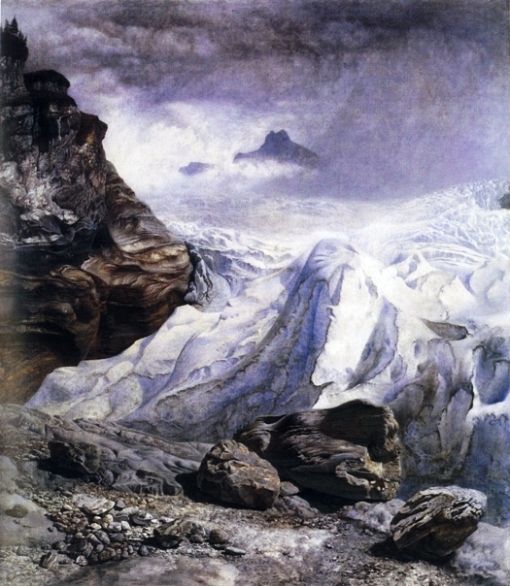
The Glacier of Rosenlaui
John Brett was born in Surrey, the son of an army officer. In the early 1850s, he took drawing lessons with James Duffield Harding and in 1854 entered the Royal Academy schools.
After a trip to Switzerland during the summer 1856, where he was fascinated by the beauty of the mountains he saw there, the painter tackled a very interesting and puzzling canvas featuring a glacier. At the time, paintings of glaciers were not common, though mountainous scenes had experienced some celebrity in previous decades, with the Romantic “rediscovery of the Alps (from the middle of the 18th Century on) – a discovery that mirrored geologists’ own fascination with mountain building processes, at least on the Continent of Europe.
The Glacier of Rosenlaui (Tate Gallery) was exhibited at the Royal Academy in 1857.
In the foreground lie three boulders and scores of pebbles. This assemblage of stones is treated with an almost visionary clarity – so much so that we can even perform a rudimentary identification of the rock types concerned. The largest boulder is metamorphic with clear undulating foliation. The shale-like stone(lower right) displays angular cleavage and sharp edges, and the boulder in the centre of the plateau has a granular texture and unstratified form.
All three differ from the bedrock, and the numerous pebbles that surround them. The peculiarity of these rocks is that they clearly do not belong – all are quite different from the limestone that lies beneath the glacier. They seem to ask the viewer – “How did we get here?”
Glacial erratics had in fact puzzled the naturalists for much of the 18th Century. What natural force could have carried such objects to their resting places? Numerous scientists had claimed that the Deluge had lifted them to the mountains tops. Sir Charles Lyell (1797-1855) suggested that they had been lodged in icebergs or ice-rafts, and deposited like dropstones. Then, in 1837, Swiss naturalist Jean Louis Rodolphe Agassiz (1807-1873) declared that glaciers had been responsible. He went on to suggest that vast sheets of ice covered much of Europe in the remote past. He also held that ice had been responsible for the periodic destruction of faunas and floras throughout Earth history, and not the “biblical” style floods suggested by Georges Cuvier (1769-1832).
It is highly likely that these rocks are invested by the artist with a real meaning, evoking the scientific turmoil of the times. By the early 1850s, Agassiz’s theories had become widely accepted and Sir Charles Lyell’s ninth edition of Principles of Geology (1853) definitely attributed the presence of erratic boulders on the Alpine Peaks to glacial action.